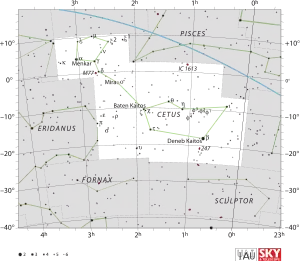Delta Ceti
Delta Ceti, Latinized from δ Ceti, is a single,[7] blue-white hued star in the equatorial constellation of Cetus. The star's apparent visual magnitude of +4.06[2] means it is near to the cusp of the faintest third of the stars that are visible the ideally-placed naked eye. It is 0.3238° north of the celestial equator compared to the celestial north pole's 90°. It is about 0.74° WNW of the spiral galaxy M77 (but which at apparent magnitude 9.6 needs magnification to be made out and has an apparent size of 0.1° by 0.12°).
 | |
| Observation data Epoch J2000.0 Equinox J2000.0 | |
|---|---|
| Constellation | Cetus |
| Right ascension | 02h 39m 28.95579s[1] |
| Declination | +00° 19′ 42.6345″[1] |
| Apparent magnitude (V) | +4.06[2] |
| Characteristics | |
| Spectral type | B2 IV[3] |
| U−B color index | −0.88[2] |
| B−V color index | −0.21[2] |
| Variable type | β Cep[3] |
| Astrometry | |
| Radial velocity (Rv) | 12.7±0.9[4] km/s |
| Proper motion (μ) | RA: 12.85±0.17[1] mas/yr Dec.: −2.94±0.11[1] mas/yr |
| Parallax (π) | 5.02 ± 0.15[1] mas |
| Distance | 650 ± 20 ly (199 ± 6 pc) |
| Absolute magnitude (MV) | −2.41[5] |
| Details | |
| Mass | 8.4±0.7[3] M☉ |
| Radius | 4.6±0.8[3] R☉ |
| Luminosity | 4,000[3] L☉ |
| Surface gravity (log g) | 4.05±0.20[3] cgs |
| Temperature | 21,900±1,000[3] K |
| Metallicity [Fe/H] | −0.24[5] dex |
| Rotational velocity (v sin i) | 7±4[3] km/s |
| Age | 7−18[6] Myr |
| Other designations | |
| Database references | |
| SIMBAD | data |
Distance and relative motion
Based upon an annual parallax shift of 5.02 mas as seen from Earth,[1] it is around 650 light years from the Sun.
Motion relative to our system's trajectory includes a highly parting vector: with a net radial velocity of about +13 km/s.[4] It moves minutely across the celestial sphere – yet just over four times more in right ascension than in declination.
Inherent properties
This is a Beta Cephei variable[3] with a stellar classification of B2 IV.[3] It varies in brightness with a period of 0.16114 days.[6] The star is about 7−18[6] million years and has a low projected rotational velocity of around 7 km/s,[3] suggesting it is either rotating slowly or is being viewed from nearly pole on.[6] It has 8.4[3] times the mass of the Sun and 4.6[3] times the Sun's radius. The star is radiating around 4,000[3] times the Sun's luminosity from its photosphere at an effective temperature of roughly 21,900 K[3]
Name
This star, along with α Cet (Menkar), λ Cet (Menkar), γ Cet (Kaffaljidhma), μ Cet, ξ1 Cet and ξ2 Cet were Al Kaff al Jidhmah, "the Part of a Hand".[8]
According to the catalogue of stars in the Technical Memorandum 33-507 - A Reduced Star Catalog Containing 537 Named Stars, Al Kaff al Jidhmah were the title for five stars :γ Cet as Kaffaljidhma, ξ1 Cet as Al Kaff al Jidhmah I, ξ2 Cet as Al Kaff al Jidhmah II, δ Cet as Al Kaff al Jidhmah III and μ Cet as Al Kaff al Jidhmah IV (exclude α Cet and λ Cet.)[9]
In Chinese, 天囷 (Tiān Qūn), meaning Circular Celestial Granary, refers to an asterism consisting of δ Ceti, α Ceti, κ1 Ceti, λ Ceti, μ Ceti, ξ1 Ceti, ξ2 Ceti, ν Ceti, γ Ceti, 75 Ceti, 70 Ceti, 63 Ceti and 66 Ceti. Consequently, the Chinese name for δ Ceti itself is 天囷九 (Tiān Qūn jiǔ, English: the Ninth Star of Circular Celestial Granary.)[10]
References
- van Leeuwen, F. (2007). "Validation of the new Hipparcos reduction". Astronomy and Astrophysics. 474 (2): 653–664. arXiv:0708.1752. Bibcode:2007A&A...474..653V. doi:10.1051/0004-6361:20078357.Vizier catalog entry
- Johnson, H. L.; Mitchell, R. I.; Iriarte, B.; Wisniewski, W. Z. (1966). "UBVRIJKL photometry of the bright stars". Communications of the Lunar and Planetary Laboratory. 4 (99). Bibcode:1966CoLPL...4...99J.
- Hubrig, S.; et al. (January 2009), "New magnetic field measurements of beta Cephei stars and Slowly Pulsating B stars", Astronomische Nachrichten, 330 (4): 317, arXiv:0902.1314, Bibcode:2009AN....330..317H, doi:10.1002/asna.200811187
- de Bruijne, J. H. J.; Eilers, A.-C. (October 2012), "Radial velocities for the HIPPARCOS-Gaia Hundred-Thousand-Proper-Motion project", Astronomy & Astrophysics, 546: 14, arXiv:1208.3048, Bibcode:2012A&A...546A..61D, doi:10.1051/0004-6361/201219219, A61.
- Anderson, E.; Francis, Ch. (2012), "XHIP: An extended hipparcos compilation", Astronomy Letters, 38 (5): 331, arXiv:1108.4971, Bibcode:2012AstL...38..331A, doi:10.1134/S1063773712050015.
- Neilson, Hilding R.; Ignace, Richard (December 2015), "Period change and stellar evolution of β Cephei stars", Astronomy & Astrophysics, 584: 6, arXiv:1509.05433, Bibcode:2015A&A...584A..58N, doi:10.1051/0004-6361/201526836, A58.
- Eggleton, P. P.; Tokovinin, A. A. (September 2008). "A catalogue of multiplicity among bright stellar systems". Monthly Notices of the Royal Astronomical Society. 389 (2): 869–879. arXiv:0806.2878. Bibcode:2008MNRAS.389..869E. doi:10.1111/j.1365-2966.2008.13596.x.
- Star Name - R.H. Allen p.160
- Jack W. Rhoads - Technical Memorandum 33-507-A Reduced Star Catalog Containing 537 Named Stars, Jet Propulsion Laboratory, California Institute of Technology; November 15, 1971
- (in Chinese) AEEA (Activities of Exhibition and Education in Astronomy) 天文教育資訊網 2006 年 7 月 11 日
External links
- "del Cet". SIMBAD. Centre de données astronomiques de Strasbourg. Retrieved 2006-11-05.
